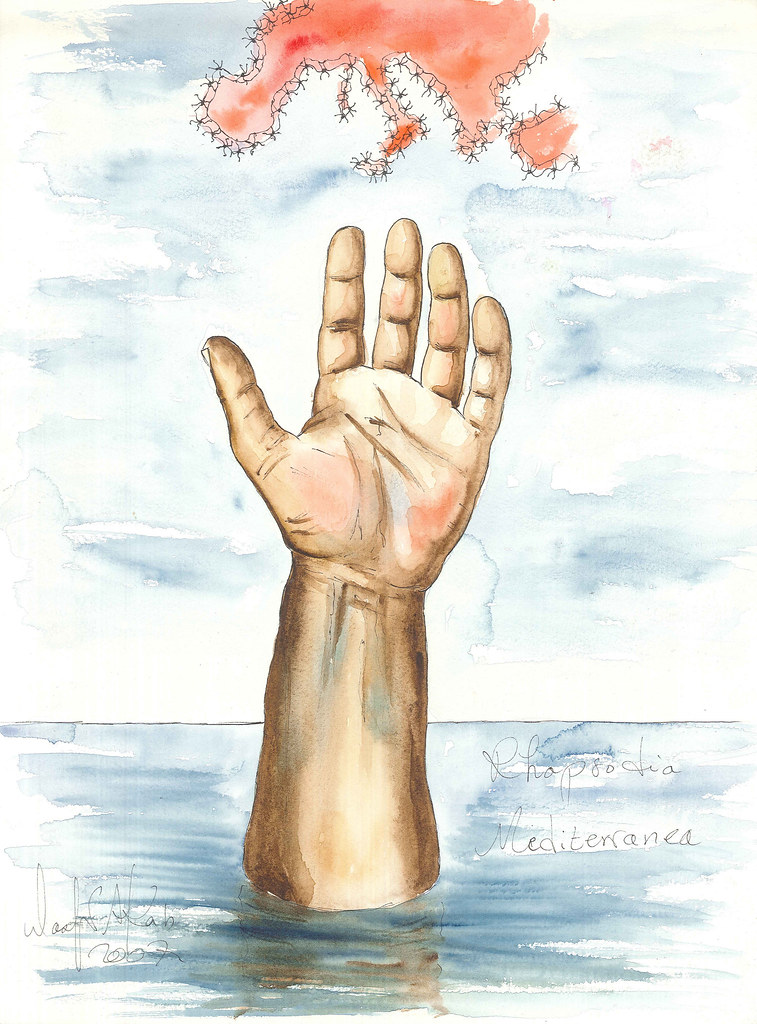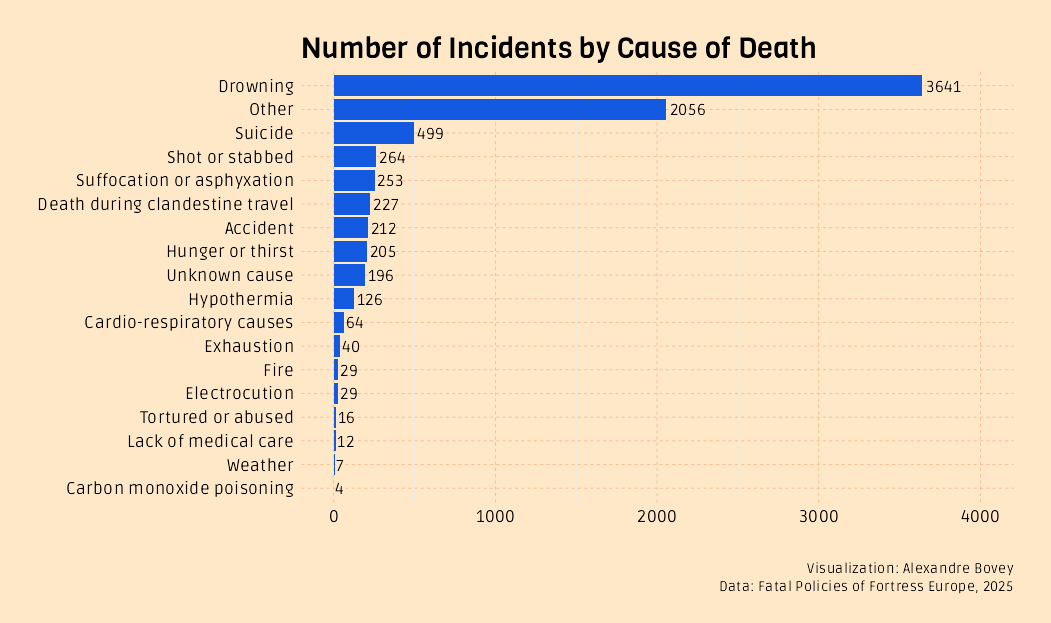Tallying the human suffering at the hands of the European border regime

By Alexandre Bovey, Research and Investigations at the Border Violence Monitoring Network (BVMN)
Header image: Mediterranean Rhapsody, by Wasfi Akab.
It’s so hard to accept that there’s no trace. Did the sea swallow them?
- Relative of one of the missing women from a ship that disappeared in January 2025 to Caminando Fronteras
10 years after the so-called long summer of migration, the deadliness of the European border regime is back in full swing. Over the past decade, national and EU authorities have worked to make migration routes into Europe more hostile and dangerous to people on the move. This, however, hasn’t stopped or even slowed down the flow of people trying to reach the continent.
According to the International Organisation for Migration (IOM), at least 2200 people died in the Mediterranean while attempting to cross to Europe in 2024 alone, on top of 743 people so far in 2025. This is partly because European governments have phased out their state-run search and rescue (SAR) operations and criminalised the non-governmental organisations (NGOs) that have intervened in their stead. In response, some European governments are now choosing to defund volunteer SAR NGOs altogether.

People on the move aboard the Sea-Watch 2 in May 2016. Credits: Brainbitch
The collective Caminando Fronteras has also provided an extensive count of the victims of what they call the “Western Euro-African Border” - namely the access routes to Spain - in the first five months of 2025. They report 1865 victims until May 31, including 38 boats that disappeared with everyone on board. The decisive factors for 47% of those deaths were “migration control policies and the erosion of life-saving standards at sea”.
We also know that thousands of people on the move (PoM) die while crossing the Sahara Desert, with at least 1180 deaths between January 2020 and May 2024. This is likely an undercount: the UN estimates that deaths of PoM in the desert are twice as numerous as the ones in the sea. Under the guise of “migration management”, the EU directly supports and is involved in the dumps of tens of thousands of Black people in the desert or remote areas by North African countries to prevent them from coming to Europe.
Another deadly route is the English channel, where over 20000 migrants have crossed since the beginning of this year. An investigation by Maël Galisson, Leon Spring and Lucy Mayblin from 2024 counted 391 migrant deaths in the Channel since 1999. We know that the UK government is paying France to violently intercept dinghies sailing for Britain, which puts the lives of people on board at risk.

Anti-immigration protesters, escorted by police, take a stroll in May 2016 along Dover's seafront, in the UK. Credits: Alisdare Hickson
Most experts estimate that the total number of deaths of people on the move on their way to Europe to be between 30000 and 60000. The Missing Migrants Project reports over 32000 people missing in the Mediterranean since 2014, while the Migrant Files investigation documented over 30000 people dying “in their attempt to reach or stay in Europe” between 2000 and 2016. Moreover, the Fatal Policies of Fortress Europe campaign has recently updated its list of deaths connected to Europe: from 1993 up to June 2025, they count a total of 66519 migrant lives lost.
In their data, we can see that the vast majority of deaths come from drowning - which is consistent with the data from the Missing Migrants Project - and most of the victims come from Sub-Saharan Africa.

The figure is likely to be much higher, as the process of documentation and counting is hampered by issues when it comes to identifying victims, verifying causes of death, as well as by the non-transparency of state authorities. For example, Lighthouse Reports have showed that many deaths along the Balkan route and at the Polish-Belarussian border go unaccounted for, notwithstanding the many coverups such as in the Pylos and Crotone shipwrecks, or the Melilla massacre.
But beyond the data, it is the harrowing testimonies of the victims of the European border regime that paint the darkest picture of its violence. In the pushback testimonies collected by BVMN, one can regularly read about border guards brutally beating people on the move, forcing them to take off their clothes, taking their phones, money and other belongings, and more forms of violence. A respondent described that one of his friends, who had just recovered from a beating, was put on a fire by Croatian border guards and one of them told him “I’ll do to you what Hitler did to the Jews.”
In the file with the deaths documented by the network UNITED for Intercultural Action (the same group behind the “Fatal Policies of Fortress Europe” campaign), violence takes on other forms, beyond mere drownings. For example, one can come across the story of two Syrian teenage boys - Abdel Razzak al Qastal (18) and Abdo al-Sayah (17) - who died from torture and beatings by Turkish border guards on March 12, 2023. Or the story of Rima al-Badi, a 21-year-old queer woman from Oman who died by suicide on September 1st of the same year, after waiting for asylum for more than a year in a hotel in Great Britain.

"Frontex kills". Photo taken in January 2011. Credits: Henning Mühlinghaus
There is also the issue of missing children and minors - who are not necessarily dead but have disappeared, which opens the possibility of them being exploited and abused somewhere out of authorities’ and the public’s sight. Between 2018 and 2020, over 18000 migrant and refugee children were reported as missing, and between 2021 and 2023 this rose to 51433 unaccompanied minors according to Lost in Europe. Based on data provided by the Italian interior ministry, of the 29903 migrants that have landed on Italian shores so far in 2025 (until June 30), 5328 were unaccompanied minors.
Is it even possible to make sense of the endless cruelty of this deadly border regime? It is one thing to analyse the capitalist reasons for the shameful exploitation or poor working and living conditions of migrants and people from immigrant backgrounds. But the murderous policies that led to this deadly system cannot be explained merely by economic factors. Rather, people on the move have been dehumanised to the point that their lives are considered disposable, so that their deaths aren’t seen by the public as the inhumane scandal that they represent.
Hence, through decades of dehumanization of migrants and refugees by politicians and the media, the rights to life and safety/dignity of people on the move have essentially been erased.
In view of the massive amount of human suffering it has never been more important to find ways to hold politicians, authorities and institutions responsible for prioritizing border violence over people’s right to life and dignity to account.
The Border Violence Monitoring Network accepts submissions for its blog. To contribute, please send your submission to press@borderviolence.eu
Thank you for your interest. We look forward to your contribution!
